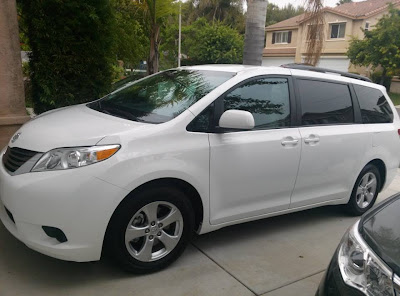This necessitated my bringing my brand new van back to the service department and leaving it with them for the day and taking a rental car instead.
So, in the past week, I have taken two car seats out of the old car, installed them in the new car, then taken them out of the new car, installed them in the rental, taken them out of the rental, and re-installed them in the new car. All at 20 weeks pregnant, I might add.
G likes the new van.
And this brings me to my major point today. It is very important that you know how to remove and re-install your car seats properly.
While I often recommend that you have your seats installed and/or checked by a Certified Passenger Safety Technician (CPST) near you (often found as a free service through your local police or fire station or hospital), you also must know how to manage your car seats on your own. There will inevitably come a time when you need to move your car seat(s) from one car to another, or take them out to clean them or the car, or rearrange them.
1. Have your seats professionally installed at least once.
If you have the opportunity, absolutely have your car seats installed and/or checked by a CPST. This will reassure you that your seats are, in fact, being used correctly. If you make any changes, such as switching from an infant carrier to a convertible seat, or turning a rear-facing car seat to face front, or adding a second car seat, you may want to return to the CPST and have them reinstall or recheck your new configuration.
2. Ask the CPST to SHOW YOU HOW to install the seat yourself.
While the CPST is doing the installation, watch what they're doing. A good CPST will show you how to fasten and lock the seat belt or use the LATCH connectors, how much to tighten the belts, and how to tell if you have a good install. S/he should also be able to show you how to correctly buckle your child into the seat. If you can, take pictures of how the seat looks when it's correctly installed.
3. READ YOUR MANUAL.
While there are some generalities we can make about car seats, each one may have some slight differences in the details. You should be familiar with your manual, know where to find it (if you can't find the one that came in your box, most companies have them available online for download), and read the instructions when attempting to remove or install the seat by yourself.
4. Know these general rules.
- Use LATCH or seat belt, but NOT BOTH to install the seat.
- Make sure you use the proper belt path for forward or rear-facing. This path should be marked on the side of the car seat itself.
- Make sure the LATCH or seat belt strap is not twisted as you feed it through the belt path.
- When forward-facing, you MUST use the top tether. If there is no hook for the top tether in the location you have chosen, then you cannot install the seat in that position.
- The LATCH or seat belt should be tight enough that you cannot jiggle the car seat more than ONE INCH side-to-side or forward and back.
- If using the seat belt, make sure that it is LOCKED. In newer cars, this simply means you should pull it all the way out and then let it retract. Tug on it to make sure it is locked.
- Look in both your car seat manual and your car's manual to check if the LATCH has an upper weight limit. If your child has reached this limit, you MUST install with the seat belt and stow the LATCH connectors.
Remember that the best car seat for your child is one that is installed and used correctly!



It really pays to know how to do the basics like removing and installing car seats. It's not everyday that you'll find someone to help you do it. If I read it right, you were 20 weeks pregnant and you're still driving a car?
ReplyDelete